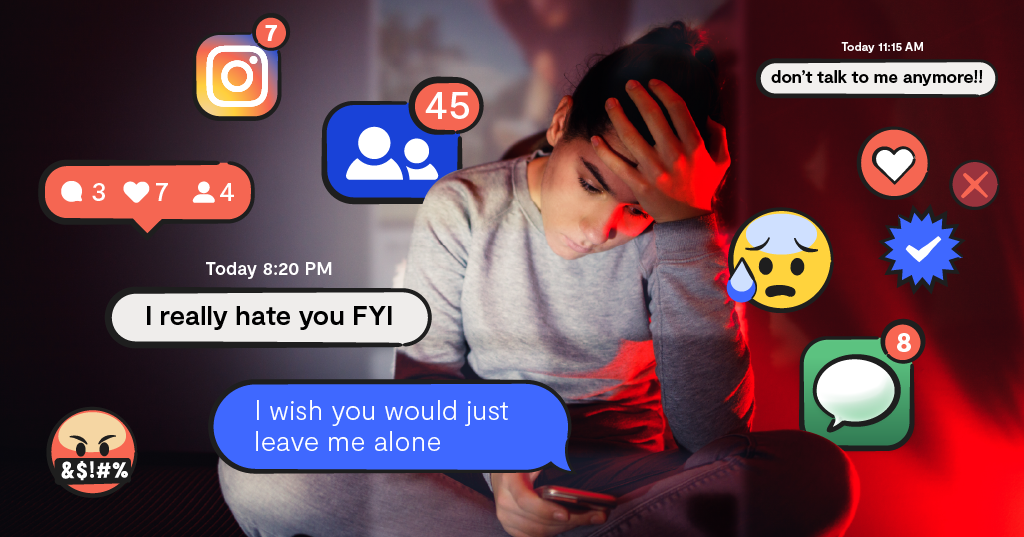
The term cyberbullying gets thrown around a lot these days — so much so that parents may grow desensitized to it. But cyberbullying is still a prominent fixture in many children’s lives, which is why it’s important to be aware of what it looks like and how it affects kids. We’ve gathered a list of seven facts about cyberbullying that may just surprise you!
7 Surprising Things Parents Don't Know About Cyberbullying
1. It’s so pervasive kids may just think it’s part of being online
In 2022, Bark found that 71.2% of tweens and 83.3% of teens experienced bullying as a bully, victim, or witness. This is an absolutely eye-opening stat that shows just how common this issue is. When kids constantly see classmates commenting mean things or hear about rumors being passed around Snapchat like wildfire, they come to accept it as part of the price of being online. There’s always the chance of a negative online consequence for upsetting someone or even worse — just experiencing random acts of aggression.
2. Cyberbullying hurts — a lot
Some adults may say “Well, at least you aren’t getting beat up on the playground like in my day,” but that’s comparing apples to oranges. Yes, physical violence is horrible, but the emotional toll that comes with cyberbullying can be just as brutal. Knowing that your peers are harassing you through social media for all the world to see is devastating, and that’s something our generation didn’t have to deal with. Some kids are so affected by cyberbullying that it can lead to anxiety, depression, self-harm, and even suicide in some tragic cases.
3. Any platform can become home to it
Cyberbullying isn’t just mean texts or aggressive Instagram direct messages. It can happen in group chats (like when you get kicked out) or even in Google Docs (if people are writing mean things about you). Kids don’t view the digital world as separate from the real world like some adults do. Texting, DMs, posts, captions, comments, and every other form of online messaging and social media are all parts of the digital structure they inhabit. And when it gets negative, it can feel overwhelming.
4. Instagram is where bullying happens the most
If Snapchat is where kids privately message, Instagram is where they “hang out.” And because of this, cyberbullying is rampant on the platform. Adults are victims of Instagram bullying too — even celebrities like Selena Gomez and Nicole Kidman have even recently been targeted on the app. Of course, the popularity of social media platforms will always wax and wane over time, but right now Instagram is the surefire hotbed home of cyberbullying.
5. The fruits of bullying can reach thousands in a matter of minutes
Spreading vicious rumors and creating fake accounts are popular forms of cyberbullying, and thanks to the internet (and the fact that we all have tiny supercomputers in our pockets 24/7), photos and videos can be shared online with thousands of people with the touch of a button. Then, when someone reposts something on TikTok, it can reach millions if it goes viral. This is definitely a far cry from someone from the next high school overhearing a rumor from last year’s prom.
6. Bullying can be hard for parents to recognize
Unless you’re well-versed in the digital world of teens, it could be easy to think your child is overreacting to a potential act of cyberbullying. There are also so many shades of it that parents could even completely overlook it when it’s happening. A child’s online world is a remarkably fragile tapestry of online connections, and everything is connected. If you’re not sure why or don’t understand why your child is upset at something that’s happening, ask them to explain it — and listen with an open heart. Hurt feelings are hurt feelings, no matter how digital or analog the cause.
7. It’s remarkably unreported
This is one way that cyberbullying is more similar to traditional schoolyard bullying — it’s hard for kids to report to adults for fear of consequences. Consequences like not being believed, being told not to be a tattle, or being instructed to handle it yourself. Then there’s the chance that the bullying will get even more aggressive because of being told on. Finally, some kids fear having their phones taken away — even if the bullying is entirely unilateral — by their parents. And for many kids, that’s a scarier prospect than being bullied, sometimes.
Stay on Top of Cyberbullying with Bark
At Bark, we know cyberbullying can be a frightening — and complicated — issue for children and parents alike. We’ve also seen firsthand how devastating the effects of cyberbullying can be. Fortunately, our award-winning monitoring service can help take some of the guesswork out of wondering how to stop cyberbullying if your kid is struggling with it. With text and email alerts from Bark, you find out what’s going on and help your kid figure out what to do next.
Interested? Try Bark free for 7 days to see how it can help your family.
Read more
Bark helps families manage and protect their children’s digital lives.





